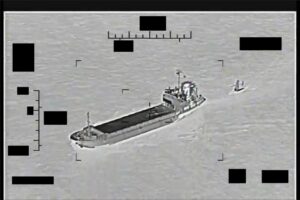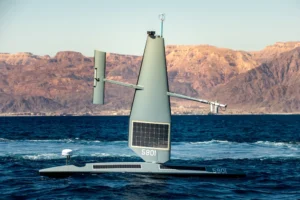The U.S. 5th Fleet on Tuesday announced it stopped an attempt by an Iranian ship to capture a U.S. Navy Saildrone Explorer Unmanned Surface Vessel (USV) in the Persian Gulf.
The service said around 11 p.m. local time Aug. 29, the 5th Fleet saw the Iran Islamic Revolutionary Guard Corps Navy (IRGCN) support ship Shahid Baziar towing a Saildrone Explorer “in an attempt to detain it” while transiting international waters.

The U.S. patrol coastal ship USS Thunderbolt (PC-12), operating nearby, responded alongside an MH-60S Sea Hawk helicopter from Helicopter Sea Combat Squadron 26, based in Bahrain.
Unspecified actions by U.S. forces led to the IRGCN ship to disconnect the towing line and leaving the area about four hours later.
“IRGCN’s actions were flagrant, unwarranted and inconsistent with the behavior of a professional maritime force. U.S. naval forces remain vigilant and will continue to fly, sail and operate anywhere international law allows while promoting rules-based international order throughout the region,” Vice Adm. Brad Cooper, commander of U.S. Naval Forces Central Command, U.S. 5th Fleet and Combined Maritime Forces, said in a statement.
Army Gen. Michael Kurilla, commander of U.S. Central Command, added in a statement that “the professionalism and competence of the crew of the USS Thunderbolt prevented Iran from this illegal action. This incident once again demonstrates Iran’s continued destabilizing, illegal, and unprofessional activity in the Middle East.”
[2 of 3] Here is a video showing support ship Shahid Baziar, from Iran’s Islamic Revolutionary Guard Corps Navy unlawfully towing a U.S. Saildrone Explorer unmanned vessel in international waters of the Arabian Gulf, Aug. 30. pic.twitter.com/12qveGsJS7
— U.S. Central Command (@CENTCOM) August 30, 2022
The Navy said the Saildrone Explorer from the incident is U.S. government property and outfitted with sensors, radars and cameras for navigation and data collection. It noted the technology aboard the vessel is commercially available and does not include sensitive or classified information.
Earlier this year, the Saildrone Explorer previously participated in the International Maritime Exercise 2022 in the region, which features 60 countries and 80 unmanned systems for the largest unmanned exercise in the world (Defense Daily, Feb. 2).

The Navy first started testing the Saildrone Explorer last December during the Digital Horizon exercise in the Gulf of Aqaba (Defense Daily, Dec. 17, 2021).
According to Saildrone’s website, the Explorer USV is about 23 feet long, is solar and wind powered and has an endurance of upward of 365 days. It is designed to carry sensors to collect data above and below the sea surface.
The Explorer has a 15-foot wing to provide wind power for forward movement and solar panels to power the payload instruments. The vessel can be equipped with an acoustic payload like a single-beam or multibeam sonar for bathymetry, an echo sounder for fisheries surveys, or an Acoustic Doppler Current profiler for current measurements.